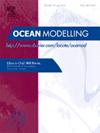Assessment of the hydrodynamical signature of the record-breaking 2021 flood along the Amazon estuary
IF 2.9
3区 地球科学
Q2 METEOROLOGY & ATMOSPHERIC SCIENCES
引用次数: 0
Abstract
Since the late 1990s, the hydrological cycle linking the Andes, the Amazon and the Atlantic Ocean has been intensifying. The Amazon estuary is the eastern terminal connection of this hydrosystem, linking the Amazon watershed to the open ocean. At Óbidos, the upstream limit of the estuary, the 2021 May-June flood was recorded as the highest flood in 12 years, with a peak discharge of 260,000 m3.s-1. The impact of this record flood has not been yet quantified along the estuary. This study aims to quantify its signature on estuarine hydrodynamics, using a cross-scale hydrodynamic model of the Amazonian estuarine continuum based on SCHISM. It turns out that the 2021 discharge anomaly (10 % above the seasonal climatology) has a prominent influence on the Amazon River from 800 km to 380 km inland, inducing water level maxima typically 0.3 m higher than during a normal flood year, and about 1 m higher than during a weak flood year. Analysis of the various hydrodynamic factors conducive to the water level maxima along the estuary (i.e. discharge, oceanic tide and atmospheric forcing) shows that this is largely due to the discharge contributing twice as much in 2021 as in a normal year. In contrast, from 380 km inland to the oceanic mouth, both in the north-western arm (the North Channel) and in the south-eastern arm (the Pará) of the estuary, the 2021 flood has no significant impact on the water level maxima dynamics, as the variability is dominated by the oceanic tide.
2021年亚马逊河口破纪录洪水的水动力特征评估
自20世纪90年代末以来,连接安第斯山脉、亚马逊河和大西洋的水文循环一直在加剧。亚马逊河口是该水系的东部终端连接,将亚马逊流域与开阔的海洋连接起来。在河口上游极限Óbidos, 2021年5 - 6月的洪水是12年来的最高洪水,洪峰流量为26万m3 / s-1。这次创纪录的洪水对河口的影响还没有被量化。利用基于SCHISM的亚马逊河口连续体的跨尺度水动力模型,量化其在河口水动力上的特征。结果表明,2021年流量异常(高于季节气候学10%)对亚马逊河内陆800 ~ 380 km范围内的影响显著,其最大水位通常比正常汛期高0.3 m,比弱汛期高约1 m。对河口沿岸水位最大值的各种水动力因素(即流量、海潮和大气强迫)的分析表明,这主要是由于2021年的流量贡献是正常年份的两倍。相比之下,从内陆到海洋口380公里,在河口的西北臂(北航道)和东南臂(par), 2021年的洪水对水位最大动态没有显著影响,因为变化主要是由海洋潮汐主导的。
本文章由计算机程序翻译,如有差异,请以英文原文为准。
求助全文
约1分钟内获得全文
求助全文
来源期刊

Ocean Modelling
地学-海洋学
CiteScore
5.50
自引率
9.40%
发文量
86
审稿时长
19.6 weeks
期刊介绍:
The main objective of Ocean Modelling is to provide rapid communication between those interested in ocean modelling, whether through direct observation, or through analytical, numerical or laboratory models, and including interactions between physical and biogeochemical or biological phenomena. Because of the intimate links between ocean and atmosphere, involvement of scientists interested in influences of either medium on the other is welcome. The journal has a wide scope and includes ocean-atmosphere interaction in various forms as well as pure ocean results. In addition to primary peer-reviewed papers, the journal provides review papers, preliminary communications, and discussions.
 求助内容:
求助内容: 应助结果提醒方式:
应助结果提醒方式:


